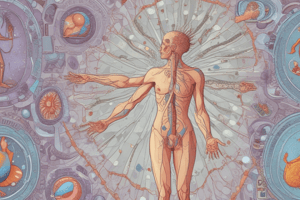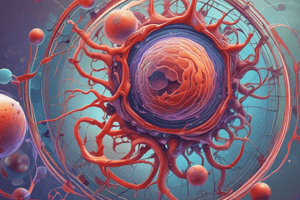Podcast
Questions and Answers
Which component of the skin contributes to its ability to block pathogens?
Which component of the skin contributes to its ability to block pathogens?
Which of the following is NOT a characteristic of innate immunity?
Which of the following is NOT a characteristic of innate immunity?
What is the role of lysozymes found in saliva?
What is the role of lysozymes found in saliva?
What action do antimicrobial peptides (AMPs) perform against bacterial cells?
What action do antimicrobial peptides (AMPs) perform against bacterial cells?
Signup and view all the answers
Which factor contributes to the acidity of the skin that helps prevent infection?
Which factor contributes to the acidity of the skin that helps prevent infection?
Signup and view all the answers
Which cell type is primarily involved in acquired immunity?
Which cell type is primarily involved in acquired immunity?
Signup and view all the answers
What mechanism do exfoliation and constant shedding of skin cells serve in the immune response?
What mechanism do exfoliation and constant shedding of skin cells serve in the immune response?
Signup and view all the answers
Which factor indicates the effectiveness of the skin as a barrier against pathogens?
Which factor indicates the effectiveness of the skin as a barrier against pathogens?
Signup and view all the answers
Which response mechanism is initiated by the presence of a pathogen at epithelial linings?
Which response mechanism is initiated by the presence of a pathogen at epithelial linings?
Signup and view all the answers
What is the consequence of the slightly acidic pH of the skin?
What is the consequence of the slightly acidic pH of the skin?
Signup and view all the answers
Study Notes
First Line of Defense
-
Physical Barriers:
- Skin: A tough, multilayered barrier. The outer layer (epidermis) contains dead keratinocytes, and the dermis contains immune cells.
- Epithelial Linings: Mucous membranes (e.g., nose, throat, intestines) trap pathogens with mucus and cilia. Expulsive reflexes (coughing, sneezing, vomiting) further remove pathogens.
- Normal Microflora: Compete with pathogens for resources, preventing their colonization.
-
Chemical Barriers:
- pH: Slightly acidic skin pH and high stomach acidity inhibit microbial growth. High salt concentration in sweat also inhibits microbial growth.
- Enzymes: Lysozymes in saliva and other secretions break down peptidoglycan in bacterial cell walls, leading to cell lysis.
-
Antimicrobial Peptides (AMPs): Present in skin and saliva. These peptides target bacterial membranes, disrupting them and causing cell death. Examples include psoriasin, defensins (alpha and beta), and lactoferrin.
- Psoriasin: Disrupts membranes and sequesters zinc.
- Defensins: Create pores in bacterial membranes, leading to cell death.
- Lactoferrin: Binds iron, depriving bacteria of a crucial nutrient. (Note: Cleaved into smaller AMPs).
Innate Immunity
-
Components:
- Macrophages, Natural Killer (NK) cells, and dendritic cells.
- Characteristics: Rapid, non-specific responses.
Acquired Immunity
-
Components:
- Lymphocytes: B cells and T cells
- Characteristics: Slow, long-lasting, and highly specific responses.
Studying That Suits You
Use AI to generate personalized quizzes and flashcards to suit your learning preferences.
Description
Explore the crucial physical and chemical barriers that form the body's first line of defense against pathogens. This quiz delves into the roles of skin, epithelial linings, and normal microflora, as well as the chemical defenses like pH and enzymes. Test your knowledge on how these mechanisms work together to protect us from infections.
![Lecture 01: First Line of Defense in Immunology [Quiz 2]](https://assets.quizgecko.com/cdn-cgi/image/width=800,height=300,fit=crop,quality=75,format=webp/quiz/ac30a2439db116a34c4b5760ddcf55e3.jpg)



